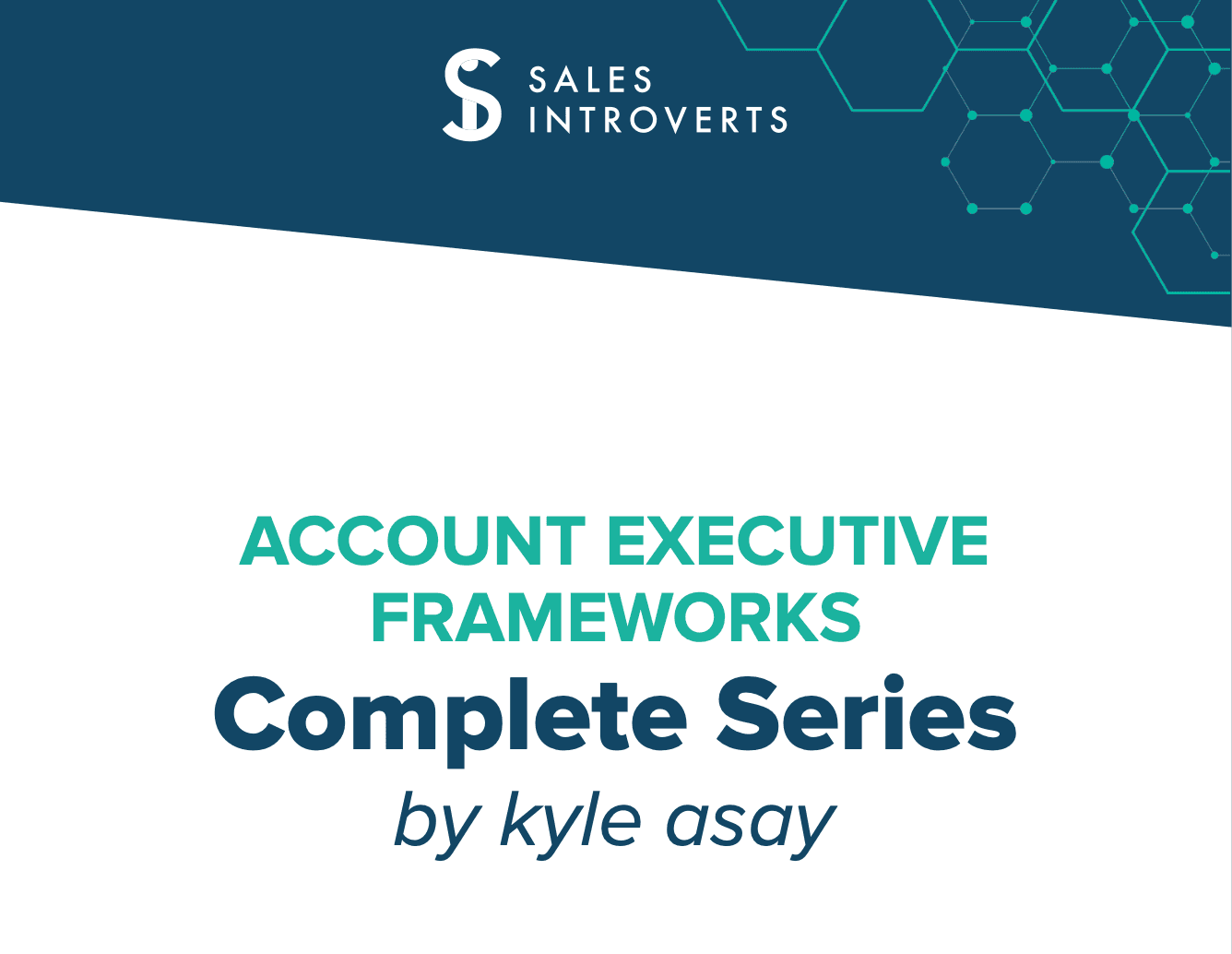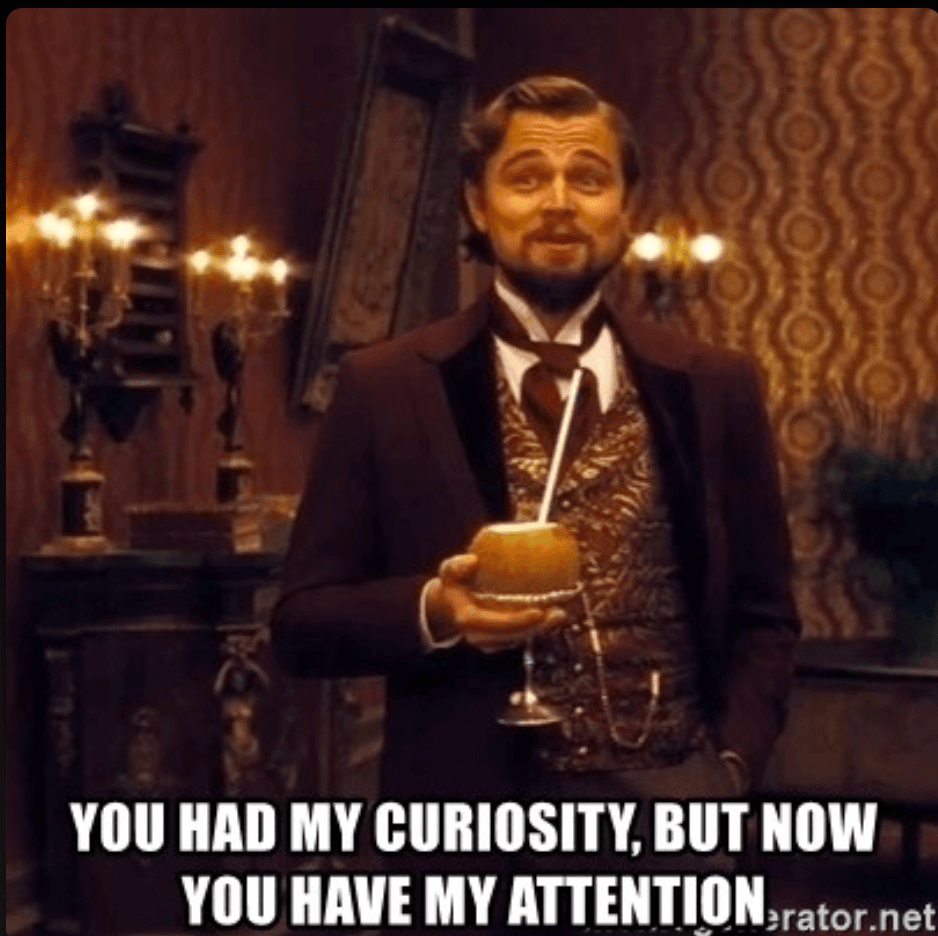Hit Quota, Secure the Bag: Account Executive Frameworks By Kyle Asay
2023 marked an exciting but terrifying pivot point in my career, moving from my comfort zone as a cybersecurity practitioner into my first sales-focused role.
It's now been 8 months since that change happened, and I've been routinely astonished at just how much I've enjoyed it on "the dark side", as I used to call it.
Whilst I've consciously sharpened my communications skills, writing ability and consultative mindset over my career, sales represented a brand new challenge.
Trying to conduct good discovery, whilst controlling the narrative and ensuring you're actually hearing your customer's pain points (instead of listening for your time to talk) - it's like trying to solve a Rubik's cube made of smoke when you're starting off.
However, I do not accept mediocrity in any of its forms, least of all in myself - so I am building myself a "sales MBA" and sharing the best tidbits about what I learn along the way.

The first resource I'm going to talk about is Account Executive Frameworks by Kyle Asay.
Whilst I'm a Senior Solutions Architect and not an Account Executive, I work hand-in-glove with AEs across the company at Bishop Fox and am thoroughly involved in the sales cycle beyond just solutioning.
Success leaves crumbs, and I wanted to deeply understand the methdology and skillset behind how the best sellers win and do so repeatedly.
Kyle is RVP North America @ MongoDB and sells Account Executive Frameworks for roughly $97 here.
Straight-up, is it worth the money? - Absolutely, and I've broken down the main "value shots" I took away from it below.
Value Shots from Account Executive Frameworks
I'll give my overall thoughts on the book at the bottom along with a rating, but if you're looking for the real actionable takeaways, they are listed in order below:
- Effective Territory Planning and Account Expansion
- Better Outreach Results Through Value Proposition and Addition
- Setting Objectives, Not Agendas & Adding Value During Discovery
- Profit Through The Pareto Principle
Effective Territory Planning and Account Expansion

For those unfamiliar or new to sales, many companies will have a sales team broken out into groups or pods, each serving a different territory of the company's customer base.
Territories can be geographic in nature (say, every customer in the Mid-Atlantic region) or categorical in nature (say, every insurance industry customer).
The group of customers a given salesperson serves and is tasked with selling to is their territory.
Here's the issue though: not all territories are made equal and there are often more companies in a given territory than one or two account executives can reasonably reach. So, how do you know where best to apply your time and energy as a salesperson?
You do it through careful territory planning and strategic account expansion.
I won't steal Kyle's thunder by listing everything he talks about here, but he did share some really interesting nuggets of wisdom worth noting down:
- Watch your data quality. A lot of prospect prioritization is based off an "account score" or similar metric heavily weighted off revenue and employee count. Have you checked if the data you're using is garbage?
- Just because your prospective customer has the ability to pay for your product or service, doesn't mean they have a good use case for it - you need both.
- Prioritise your targets based on whether they have budget and a use case for your product/service first, then those with only one of those second.
- If you're looking to expand the amount sold to a customer in your territory, this needs to start months in advance.
- What problems are you solving right now for your customer, and which should you be solving?
This isn't even 5% of what's in this section of Account Executive Frameworks, and I'll definitely be working some of this stuff into my workflow at Bishop Fox.
Better Outreach Results Through Value Proposition and Addition

Doing prospect outreach is often a stress-inducing exercise that ranks up there with the dentist in terms of activities you don't look forward to.
You're fighting an uphill battle for attention from the outset, against an extremely busy and educated customer base trained to pick up on common sales tactics and attempted personalization.
To add extra spice to this already Sriracha-drenched situation, a lot of email/LinkedIn/customer outreach is godawful and a real mis-step might end up with you getting lit up on someone's LinkedIn!
So, what are we to do as salespeople?
Unfortunately, there's no secret blend of herbs and spices to give you here - you have to actually be better.
Thankfully, this has its own section in Account Executive Frameworks breaking down how to structure your outreach and fit it into your wider territory plan, like we just looked at!
Prospect Priorities: Deepening Your UnderstandingFor those unfamiliar, many sales organizations will have already strategized with their leadership, marketing, product and sales professionals to come up with ideal customer personas/profiles (ICPs).
These ICPs represent the ideal, best-fit description of an individual or company that would most benefit from your product/service.
However, while the person you're looking at talking to might look like your ICP, it is highly unlikely that they'll exactly match your ICP. They'll have their own conflicting priorities that you'll have to learn to customize your approach to.
Whilst Kyle himself goes into depth on how to do this, this is actually something I've found to work really well across hundreds of client communications:
- What does the specific person you're talking to actually care about? Not their company, them specifically within that company.
- How is that individual measured? How do they get rewarded, promoted and/or punished?
The answer to the second question will very likely inform the answer to the first question.
A VP of Sales is measured on attainment of quota across the account teams they manage - when the team succeeds, the VP succeeds.
A technical manager of an engineering department might be measured on their number of tickets closed or features shipped, depending on the company.
A CISO is going to be measured on the cleanliness of their security audit and penetration test reports and any tangible impact metrics that illustrate improvements due to their actions.
Each of these individuals has a different set of priorities, a different scope to buy and effect change within the organization and will care about differing things.
Tailor your outreach to make your prospect look like a rockstar afterwards based on their priorities and how they measure success and you'll likely find you get better responses!
Value Proposition & Value Addition in Cold OutreachThe salesperson has an extremely difficult job with their outreach efforts.
By its very definition, cold outreach from a salesperson represents a pattern interrupt to the receipient. The time taken to read and potentially reply/react to an email you send is time they could be spending reviewing pull requests, on meetings, or working.
Who are we kidding? It's almost certainly writing a different email, but you get the point!
After crafting a subject line and opening that grabs the prospect's attention, you need to prove why your email was worth opening quickly and very well to get that all-important reply. Your outreach should first and foremost contain your value proposition.
You're a salesperson and you ideally work for a company whose product you believe has value, there's no need to endlessly apologize for doing your job in communicating that value. You just need to do it well!
If you did the Prospect Priorities portion right, you should know what the person you're reaching out to cares about first and foremost. This is what we'll craft the value proposition around.
Let's say you're reaching out to the CISO of a regional bank or financial services company about penetration testing services:
- We already know that CISOs are measured primarily on tangible security-related impacts and the cleanliness of third-party compliance audits and penetration tests conducted.
- Success and keeping their job as a financial services/banking CISO looks like less vulnerabilties in the company's systems year-on-year, a clean or healthy compliance audit report from banking regulators/external auditors and usable proof the controls they design as part of their overall risk management program are working.
- Used correctly, penetration testing can help achieve all three of these, but we shouldn't assume the prospect knows this. It is our job as salespeople to communicate this value.
- Penetration testing can be used as a "radar sweep" of the company's systems to discover vulnerabilities in net-new environments or in a "depth-drilling" approach to really hammer on a soon-to-be-released application or system.
- Those discovered vulnerabilities can then be remediated, the fix activity documented and packaged along with the penetration testing report to act as evidence to auditors that the company is following its regulatory duty to look for technical weaknesses.
- This combined evidence will help the CISO get their healthy audit report and ideally discover less and less vulnerabilities on repeat annual tests. This in turn can be used as proof the CISO's efforts are working to their superiors.
We can pair this with value addition to really sit into the one-two punch we're throwing.
- Customer testimonials
- Case studies
- Articles the company has written relevant to the CISO's company
- An article that aligns with previous posting activity from the individual you genuinely think they might find interesting.
Let's package it up into an example:
Subject: 2023 is rough for CISOs - let's get ahead of the curve?
With this year going the way it has for cybersecurity professionals, continued success requires careful, excellent use of the CISO's Holy Trinity:
- A strong game-plan for tackling an exploding risk landscape,
- A trusted partner to help with security challenges the organization isn't equipped to deal with on their own,
- A good recommendation for a strong single-malt Scotch or bourbon.
[Your Company] can help you evidence tangible success on the first two bullets through collaboratively aligning our industry-leading penetration testing services with GeneriBank's strategic risk management program to discover the state of net-new systems, deep-dive into mission-critical business systems, and provide usable proof of any improvements to communicate to the board that your efforts at GeneriBank are paying off.
We have a proven track record of doing just that with organizations just like GeneriBank. For example, our work with CornHusker Credit Union has resulted in year-on-year improvements in their security posture as measured through our reporting and successful business cases for additional security headcount in a challenging economic climate. Read the full case study [here] if you're interested!
As for the third bullet, let's talk and we can toast to your future success at DEF CON this year, if you're attending? Does Friday the 25th work for you?
Kind regards, Matt Twells

Setting Objectives, Not Agendas & Adding Value During Discovery
 Setting a course for better sales calls!
Setting a course for better sales calls!
Don't worry, this section won't be anywhere near as long!
Fundamentally, you are not the only seller that your prospect has chasing after them for their time and calls get exhausting after a while.
This goes double if the last couple of sellers weren't very good or didn't conduct their discovery portion of the sales cycle correctly.
For those unfamiliar, discovery is the portion of the sales cycle where the seller asks targeted questions to gain as deep and accurate an understanding of:
- What's happening right now (current state)
- Where the prospect and organization as a whole see themselves going (future/aspirational state)
- What current business processes, challenges or issues are stopping the prospect from getting there (the customer pain)
The better you conduct discovery, the better and more convincing the solution you propose will be!
The issue Kyle ably points out here is that discovery is exhausting to answer and your prospect can absolutely get discovery fatigue. You'll spot this by curt, short responses to your questions and a general lack of enthusiasm on their part.
"Just tell me what you do, you're the one who asked for this call!"Questions like this are explicitly designed to send badly prepared salespeople into a panic and allow the prospect to take control. If this happens, your potential deal is likely dying on the operating table.
The way we avoid this situation is by setting an objective, not an agenda for the call.
That way, your prospect knows exactly what you're looking to achieve, what you need to achieve it, and by extension what they are going to get out of it.
Kyle puts this in a really great, actionable soundbite and provides excellent examples - but fundamentally you need to make sure you've communicated:
"By the end of today's call, I will show you X / recommend Y / do Z. To achieve that and provide specific advice, I need to understand A, B and C thing better by exploring D thing with you."This is a premise that instinctually makes sense to many of your prospects and immediately communicates that you know your shit and came prepared. This is never a bad thing to communicate, regardless of situation.
You can also drastically improve your discovery through value addition.
I personally like to do this by referring to a similar situation at a previous point in my career that gave me an insight that I share with the prospect during discovery.
This teaches the prospect something they maybe didn't know and at minimum provides a useful insight, and thus increases the chances of fruitful discovery answers.
Try something like the following:
"I noticed you mentioned that your company is working towards SOC2 certification within the next year or so. I'm interested in how your company is managing complying with the access control aspects of that framework. The reason I asked is because in a previous role, a client found real success by doing X thing and I'm curious whether you're doing something similar at GeneriBank?"The discovery question is about access control, X thing is your company's differentiator or service, and your prospect got their value addition by finding out what worked for another company for free.
Profit Through The Pareto Principle

The last value shot I really liked from Account Executive Frameworks was Kyle's exploration of the Pareto Principle.
For those unfamiliar, Vilifred Pareto was an Italian economist and sociologist who in the late 19th/early 20th centuries noted that 80% of the land in Italy was owned by 20% of the population.
Intrigued, he investigated other countries and other data populations and found multiple other instances where this "80% of results come from 20% of inputs" distribution also appeared:
- 20% of the pea pods in Pareto's garden produced 80% of the pea yield,
- He found that this roughly applied to wealth and income distribution in many countries, also.
In the mid-to-late 20th century, consultants and authors the world over took this observation and called it the Pareto Principle.
It's really important to remember the Pareto Principle is more something we see appear a lot as opposed to a hard and fast mathematical rule.
Inputs do not create outputs in this linear, scaled fashion in every context, and conclusions drawn from this model run the risk of being very wrong.
Practise safe extrapolation, kids!
Kyle uses this concept I'd say pretty accurately in this book, coming up with something that I'm going to remember for a good, long time:
"80%+ of the functionality you cover in your product demonstrations is offered by your competition. If you spend most of your demonstration covering that functionality, you lose because you are not differentiated. Instead, spend 20% of your time covering that 80%, and call out that you know it’s table-stakes functionality that everyone offers."
Adjust your workload and approach accordingly!
TL;DR / In Conclusion
Kyle Asay's Account Executive Frameworks is an excellent, straight-to-the-point resource full of tactical, usable insights.
The "silver bullet" example you're looking for to guarantee a close every time isn't in here, because it doesn't exist.
What is in here is everything you'll need to craft your own ammunition to succeed all on your own.
I learnt a lot from this and will absolutely be re-reading and recommending this book to other salespeople and my colleagues.
Overall Score: 9.5/10